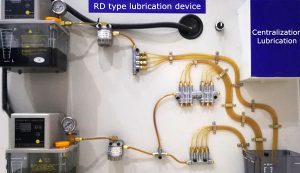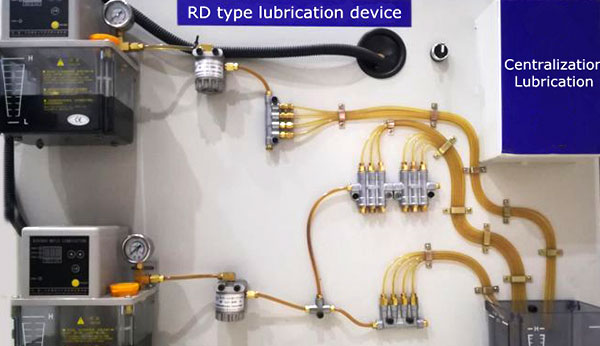Machine tool lubrication system occupies a very important position in the machine tool. Its design, debugging and maintenance play a very important role in improving the machining accuracy of machine tools and prolonging the service life of machine tools. The lubrication of modern machine tool guide rail, lead rod and other sliding pairs is basically the use of centralized lubrication system.
Centralized lubrication system is provided by a hydraulic pump displacement, a certain pressure of lubricating oil, for the main and second oil system in all of the diverter on the oil supply, while the shunt the oil into all lubricating points according to the required oil distribution: at the same time, by the controller to complete lubrication time, number of monitoring and malfunction alarm and shutdown, and other functions, to achieve the goal of automatic lubrication.
The characteristics of centralized lubrication system are timing, quantification, accuracy, high efficiency, convenient and reliable use, which is conducive to improving machine life and ensuring service performance. Centralized lubrication system can be divided into damping lubrication system, progressive lubrication system and volumetric lubrication system according to the lubrication elements used.
1. Single line damping lubrication system This system is suitable for machine tool lubrication point oil demand is relatively small, and the need for periodic oil supply. It is the use of damping distributor, the pump out of the oil in a certain proportion to the lubrication point. Generally used in circulation system, can also be used in open system, through time control, to control the amount of oil lubrication point. The lubrication system is very flexible, one more lubrication point or one less can be, and can be installed by the user, and when a point is blocked, does not affect the use of other points, so it is widely used.
2. Progressive lubrication system is mainly composed of a pump station, and progressive shunt and can be attached to control device to monitor. The feature is that it can alarm the blockage of any lubricating point and terminate the operation to protect the equipment; Accurate quantification, high pressure, not only can use thin oil, but also suitable for the use of grease lubrication. Lubrication points up to 100, pressure up to 21MPa. The progressive diverter comprises a bottom plate, an end plate and less than three middle plates. A set of valves can have up to 8 intermediate plates and lubricate up to 18 points. The working principle is that the plunger in the middle plate acts from a certain position to supply oil. If a certain point is blocked, the next oil outlet will not act, so the whole shunt stops supplying oil. The clogging indicator can indicate the clogging location for easy maintenance.
3. Volume type lubrication system The system with proportional valve as the distributor to the lubricating oil in the system is equipped with pressure relay, oil pressure system to the expected value of backwardness, make motor delay stop, lubricating oil from quantitative dispenser supply system by reversing valve unloading, and maintain a low pressure, make quantitative valve distributor add lubricating oil, motor starting again, Repeat this process until the specified lubrication time is reached. The system’s pressure is generally below 50MPa, the lubrication point can be up to hundreds of, and its wide application range and reliable performance can not be used as a continuous lubrication system. The structure principle of the quantitative valve is: composed of the upper and lower two oil chambers. Under the high pressure of the system, the oil is hit to the lubrication point, at low pressure, by its own spring reset and bowl seal will be stored in the lower chamber oil pressure is located in the upper chamber of the oil discharge chamber, displacement of 0.1 ~ 1.6mL, and can be combined according to the actual need.


